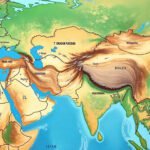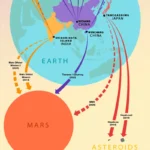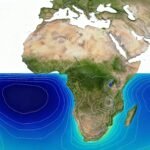Ceres – The Small World with Big Secrets
Ceres, the dwarf planet orbiting quietly in the asteroid belt, has turned out to be one of the Solar System’s most surprising worlds. NASA’s Dawn spacecraft revealed bright white spots in its Occator Crater, which at first looked like ice. Later analysis showed they were sodium carbonate salts, left behind when salty water erupted from deep inside and froze on the surface — a process called cryovolcanism. Even more intriguing, these salt patches are geologically young (2–9 million years old), suggesting that Ceres may still hide liquid reservoirs of brine beneath its crust. Dawn also detected organic molecules near Ernutet Crater. Taken together — water, organics, and internal heat — the evidence shows that Ceres once had conditions suitable for life, and maybe still has the chemistry for it today.
The Wow! Signal – A Mystery Rekindled
In 1977, a 72-second burst of radio energy from the direction of Sagittarius stunned astronomers. It became known as the Wow! Signal after astronomer Jerry Ehman scribbled “Wow!” on the printout. For decades, no one could explain it, and searches of the same region came up empty. Recently, astronomer Alberto Caballero examined data from ESA’s Gaia mission and identified a Sun-like star (2MASS 19281982-2640123) about 1,800 light-years away in the exact patch of sky. While no new signals have been detected — coordinated follow-ups in 2022 using the Green Bank Telescope and Allen Telescope Array found nothing unusual — the discovery of such a star gives astronomers a clear target for future SETI searches.
UFOs and the Interdimensional Hypothesis
Closer to home, unidentified aerial sightings continue to stir public interest. The U.S. government created the All-domain Anomaly Resolution Office (AARO) to investigate these reports. Out of 757 cases logged between May 2023 and June 2024, the vast majority were identified as drones, balloons, or sensor artifacts. Only 21 remained under analysis, and AARO stated clearly that none showed evidence of extraterrestrial technology. Some researchers speculate about the interdimensional hypothesis — the idea that these anomalies might come from parallel dimensions rather than distant planets — but this remains firmly in the realm of theory. While quantum physics allows for the possibility of parallel worlds, there is currently no experimental proof to connect them with UFO sightings.
Candidate One – A Neighbor in Alpha Centauri
The Alpha Centauri system, just 4.3 light-years away, is our closest stellar neighbor and a prime target in the hunt for habitable worlds. Using the Very Large Telescope (VLT) in Chile, astronomers detected a faint thermal signature near Alpha Centauri A in 2021, which they nicknamed Candidate One (C1). The possible planet appears to orbit in the star’s habitable zone, but its estimated size — between Neptune and Saturn — suggests it is likely a gas giant. While such a planet wouldn’t host life itself, large moons around it could potentially have oceans and atmospheres. Importantly, Candidate One is still unconfirmed. Follow-up observations with the James Webb Space Telescope are ongoing, and scientists caution it might turn out to be an observational artifact or a dust cloud. If confirmed, however, it would be the closest potentially habitable world yet discovered.











